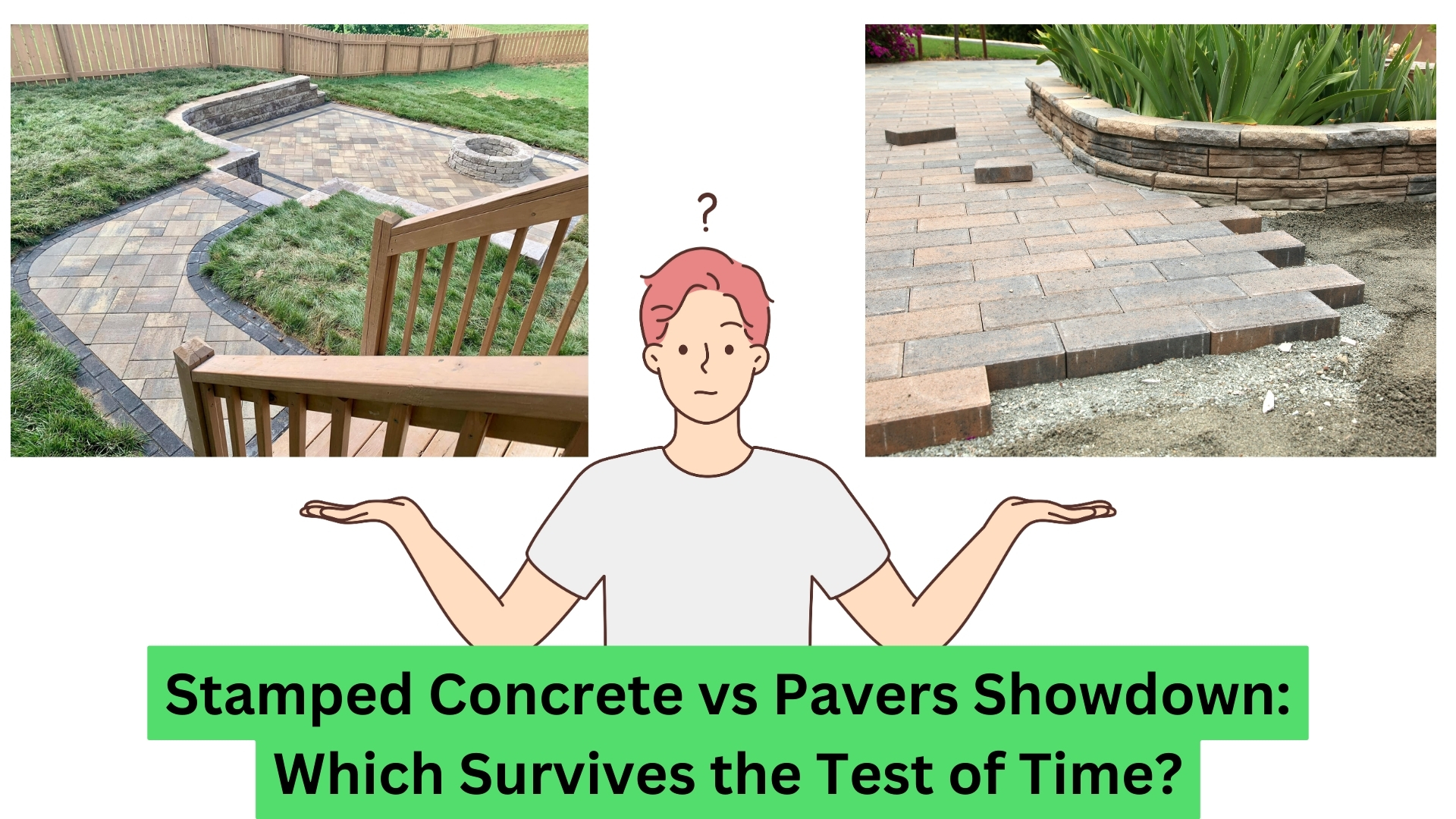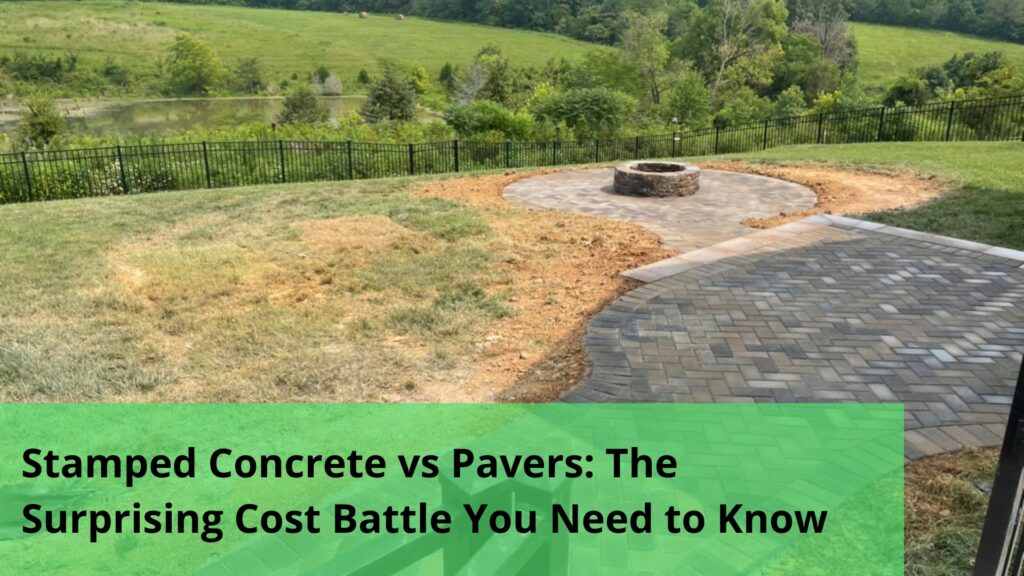Introduction
When it comes to landscaping and paving, homeowners in Clarksville, TN are faced with a crucial decision: stamped concrete or pavers? This choice is not just about aesthetics; it’s about selecting a surface that will endure the test of time, withstand the elements, and still maintain its beauty. In this in-depth exploration, we pit stamped concrete against pavers in a showdown to determine which is the ultimate champion in durability, cost-effectiveness, and design flexibility.
Why should you keep reading?
- Uncover the Truth: We demystify the pros and cons of each material, providing you with the facts you need.
- Make Informed Decisions: Armed with knowledge, you can choose the best option for your home.
- Save Money in the Long Run: Understand the long-term costs and maintenance requirements.
- Design Your Dream Space: Discover the vast array of design possibilities each option offers.
- Boost Your Home’s Value: Learn how the right choice can enhance your property’s curb appeal and resale value.
Understanding the Basics
Before we delve deeper into the comparison, it’s essential to understand what each option entails. Both stamped concrete and pavers offer unique benefits and challenges.
Here’s a breakdown:

What is Stamped Concrete?
- Variety of Looks: With a range of patterns and colors, stamped concrete can be customized to suit any design preference.
- Single Slab Advantage: It’s a continuous slab, which means fewer joints or gaps where weeds can grow.
- Customizable Patterns: From intricate designs to simple textures, stamped concrete offers vast creative freedom.
What are Pavers?
- Diverse Materials: Pavers come in various types, including concrete pavers, brick pavers, and natural stone pavers.
- Flexibility in Design: With different shapes and sizes, pavers allow for unique and complex patterns.
- Ease of Repair: Individual pavers can be replaced if damaged, making repairs simpler.
The Durability Factor
Stamped Concrete Durability
- Crack Resilience: While being a single, solid slab makes it strong, it also makes it prone to cracking over time, especially in areas with freeze-thaw cycles.
- Maintenance Needs: Regular sealing is necessary to maintain its appearance and prevent cracks.
- Longevity: With proper maintenance, stamped concrete can last 25 years or more, but the lifespan can be shortened by environmental factors and heavy loads.
Pavers Durability
- Resistance to Cracking: Individual units can move slightly without cracking, making them ideal for areas with temperature fluctuations.
- Load Bearing: They can handle heavy loads and are less likely to crack under pressure.
- Repair Ease: If a paver is damaged, you can simply replace the individual piece, not the entire area.
Aesthetic and Design Considerations
Design Versatility of Stamped Concrete
- Customization: It offers a vast array of textures and colors. Stamping techniques can replicate the look of natural stone, brick, slate, and even wood.
- Color Options: With a range of concrete stains and color hardeners, the possibilities for customizing your stamped concrete are nearly endless.
- Seamless Beauty: As a continuous piece, stamped concrete can create a uniform and cohesive look, enhancing the overall appearance of your outdoor space.
Pavers’ Design Flexibility
- Shapes and Sizes: Available in a variety of shapes and sizes, pavers offer the flexibility to create unique and complex patterns.
- Color Varieties: Pavers come in multiple colors, allowing for creative combinations and designs.
- Textural Differences: Different materials offer different textures, from the smoothness of concrete pavers to the rugged feel of natural stone.
Installation and Maintenance Showdown
Installing Stamped Concrete
- Process: It involves pouring the slab, adding color, and then stamping the desired pattern before the concrete sets.
- Timeframe: The installation is generally quicker than laying individual pavers, but it requires precise timing and skill.
- Professional Installation: Due to the complexity and the need for specialized tools, professional installation is recommended.
Laying Down Pavers
- Preparation: It starts with preparing the base, which is crucial for preventing pavers from shifting.
- Placement: Pavers are laid individually, allowing for adjustments as you go.
- DIY-Friendly: While time-consuming, laying pavers can be a DIY project, but professional installation ensures longevity and proper alignment.
Long-Term Maintenance: Stamped Concrete vs Pavers
- Stamped Concrete Maintenance: Requires resealing every 2-3 years to protect the surface and maintain its color. Cracks, if they occur, can be challenging to repair seamlessly.
- Paver Maintenance: Involves regular cleaning and reapplying joint sand. Individual pavers can be replaced easily if damaged.
- Weed and Moss: Pavers might need attention to prevent weed growth in the joints, a problem less likely with stamped concrete.
Cost Analysis Over Time
Initial Cost of Stamped Concrete vs Pavers
- Stamped Concrete: Generally, stamped concrete is less expensive per square foot than pavers. The cost can increase with more intricate designs and custom colors.
- Pavers: The cost per square foot for pavers tends to be higher, especially for high-end materials like natural stone. The complexity of the pattern also influences the price.
Long-Term Costs: Which is More Economical?
- Maintenance and Repair Costs:
- Stamped Concrete: Lower maintenance costs initially, but repairing cracks or color fading can be costly.
- Pavers: Regular maintenance like joint sand replenishment and weed control can add up, but individual paver replacement is usually affordable.
- Lifespan and Durability: While both can last for decades, the ease of repairing pavers can make them more economical in the long run.
Making the Right Choice for Your Home
Factors to Consider in Your Decision
- Climate and Environment: Consider the climate in your area. Areas with freeze-thaw cycles may see more benefit in pavers due to their resistance to cracking.
- Budget Constraints: If you have a tight budget, stamped concrete might be the more economical upfront choice.
- Aesthetic Preferences: Think about the desired look and feel of your outdoor space. Stamped concrete offers a wide range of decorative options, while pavers provide a classic, timeless appeal.
- Maintenance Willingness: Consider how much time and effort you’re willing to invest in maintenance. Stamped concrete requires less frequent but more intensive maintenance, whereas pavers require regular, simpler upkeep.
- Long-Term Value: Evaluate the potential impact on your property’s value. Both options can add curb appeal, but the right choice depends on your home’s style and the prevalent trends in your neighborhood.
Making an Informed Choice
- Weigh the pros and cons of each material against your personal needs and preferences.
- Consult with professionals for advice tailored to your specific situation and location.
- Consider visiting homes or showrooms to see both options in person, as real-life examples can provide valuable insight.
Initial Cost of Stamped Concrete vs Pavers
- Stamped Concrete: Generally, stamped concrete is less expensive per square foot than pavers. The cost can increase with more intricate designs and custom colors.
- Pavers: The cost per square foot for pavers tends to be higher, especially for high-end materials like natural stone. The complexity of the pattern also influences the price.
Long-Term Costs: Which is More Economical?
- Maintenance and Repair Costs:
- Stamped Concrete: Lower maintenance costs initially, but repairing cracks or color fading can be costly.
- Pavers: Regular maintenance like joint sand replenishment and weed control can add up, but individual paver replacement is usually affordable.
- Lifespan and Durability: While both can last for decades, the ease of repairing pavers can make them more economical in the long run.
Conclusion
In the quest to determine whether stamped concrete or pavers are the best choice for enduring the test of time, we’ve explored various facets from durability and design to cost and environmental impact. The decision ultimately hinges on your specific needs, preferences, and the unique characteristics of your property.
As you ponder over this significant decision for your home, remember that choosing the right materials and installation professionals is crucial. At Borja Outdoor, we specialize in transforming outdoor spaces into beautiful, functional, and lasting areas of enjoyment. Whether you lean towards the seamless elegance of stamped concrete or the classic charm of pavers, our team is equipped to bring your vision to life with expertise and craftsmanship.
Explore our services and get personalized advice for your project. Let’s create an outdoor space that not only looks fantastic today but stands strong for years to come.




